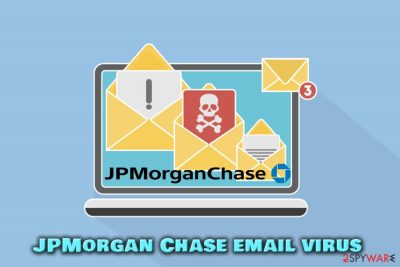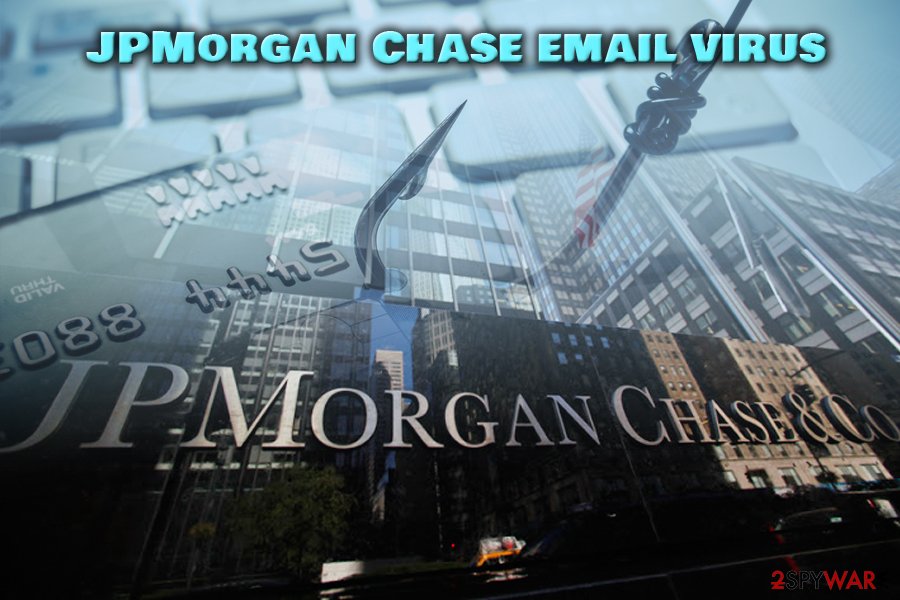JPMorgan Chase email virus (Free Instructions) - Simple Removal Guide
JPMorgan Chase email virus Removal Guide
What is JPMorgan Chase email virus?
JPMorgan Chase email virus is a phishing email campaign that targets banking information

JPMorgan Chase email virus is a malspam campaign that uses the name of the biggest bank in the world to spread malware that is capable of stealing banking credentials. Cybercriminals send out thousands of phishing emails to unsuspecting users, expecting that some will take the bait. Because it is a high-profile bank, there is a high chance that the email will land in an inbox of a person who actually uses the bank. According to researchers, fake JPMorgan Chase emails used several different banking trojans[1] (Dyre, Emotet) that were injected via a malicious link or an attachment inside the phishing emails.
| Summary | |
| Name | JPMorgan Chase email virus |
| Type | Banking trojan |
| Distribution | Phishing email |
| Main dangers | Stolen banking credentials and other sensitive data |
| Related malware | Dyre, Emotet and others |
| Detection and elimination | Use FortectIntego, SpyHunter 5Combo Cleaner or Malwarebytes |
Phishing emails are prevalent method of malware distribution and JPMorgan Chase email virus authors use it as well. Hackers employ social engineering skills to make fake messages look more believable, and many users still fall for them. Bad actors use logos, formatting and similar email addresses that resemble legitimate companies. The attachments inside or links hide malicious payload which, once clicked, get executed and infect the machine with malware.
JPMorgan Chase email virus attacked users several times over the years.[2] While some hackers lead victims to fake login sites that look genuine in order to retrieve the valuable banking information. This information can be later used to steal money from the account. Additionally, other harvested data, such as names, emails, home addresses, can be traded on the Dark Web.
The data leak of such kind put individuals in danger. Stolen money from the bank might be returned once the fraud is investigated. However, JPMorgan Chase email virus can also result in identity theft. Victims might have to pay for the mortgage, lease or other items they never bought. Therefore, JPMorgan Chase email virus removal should not be delayed.
Those who do not provide their credentials on the phishing sites might infect their machines with a banking trojan or another malware. Unfortunately, trojans are sneaky infections that are extremely hard to spot, as they emit almost no symptoms. In some cases, users might spot the following:
- Increased CPU/GPU usage
- Software crashes or freezes
- Increased amount of ads that lead to dangerous sites
- Unknown processes running in the Task Manager
- Overall slowdown of the device
Because trojans generally show no signs of infections, it is vital to scan your computer using reputable security software like FortectIntego and SpyHunter 5Combo Cleaner. It will help you remove JPMorgan Chase email virus or any other infections present on the computer.

Learn to recognize scams
By now, most of us are aware of scams that float around the internet – especially those that are poorly designed. They are often littered with spelling or grammar mistakes, are sent from unknown email addresses and merely look unprofessional in general. Nevertheless, there are also less aware people who do not pay much attention to such details and fall for the fake message.
However, some crooks compile emails of superior quality, and even those who are more computer-savvy and experienced might be scammed. Therefore, even if the email looks legitimate, users should not rush opening attachments or click on links. Beware that some phishing emails can surpass the built-in scanner and end up in your Inbox instead of a Spam folder.
The less noticeable signs are as follows:
- The title of the message does not indicate the name of a person who is being addressed to. High-profile organizations know your name, and will always use it. Therefore, if you noticed “Dear Customer” or a similar phrase, it is highly likely that the email is fake;
- The email address is similar, but not the same, as a legitimate one. Crooks often use email addresses that look almost identical to original ones (e.g., paypal@mail.peypal.com) and the differences might not be noticed at the first glance;
- The author asks for an urgent action. Typically, crooks rely on human emotion of panic and threaten users that their account will be closed, or compromised, and similar. Never panic and call your bank to make sure the message is legit.
Eliminate JPMorgan Chase email virus from your PC
If you clicked on suspicious links or executed an attachment from an unknown email, you will have to remove JPMorgan Chase email virus from your machine. Because the injected malware is a banking trojan which performs various changes to the system, manual JPMorgan Chase email virus removal is not recommended by experts.[3]
Instead, users should download and install reputable anti-malware solutions, such as FortectIntego or SpyHunter 5Combo Cleaner. These applications are capable of detecting and shutting down the infection completely. In case the JPMorgan Chase email virus stops security software from performing well, you should enter Safe Mode with Networking as explained below.
Getting rid of JPMorgan Chase email virus. Follow these steps
Manual removal using Safe Mode
To disable JPMorgan Chase email virus safely, enter Safe Mode with Networking:
Important! →
Manual removal guide might be too complicated for regular computer users. It requires advanced IT knowledge to be performed correctly (if vital system files are removed or damaged, it might result in full Windows compromise), and it also might take hours to complete. Therefore, we highly advise using the automatic method provided above instead.
Step 1. Access Safe Mode with Networking
Manual malware removal should be best performed in the Safe Mode environment.
Windows 7 / Vista / XP
- Click Start > Shutdown > Restart > OK.
- When your computer becomes active, start pressing F8 button (if that does not work, try F2, F12, Del, etc. – it all depends on your motherboard model) multiple times until you see the Advanced Boot Options window.
- Select Safe Mode with Networking from the list.

Windows 10 / Windows 8
- Right-click on Start button and select Settings.

- Scroll down to pick Update & Security.

- On the left side of the window, pick Recovery.
- Now scroll down to find Advanced Startup section.
- Click Restart now.

- Select Troubleshoot.

- Go to Advanced options.

- Select Startup Settings.

- Press Restart.
- Now press 5 or click 5) Enable Safe Mode with Networking.

Step 2. Shut down suspicious processes
Windows Task Manager is a useful tool that shows all the processes running in the background. If malware is running a process, you need to shut it down:
- Press Ctrl + Shift + Esc on your keyboard to open Windows Task Manager.
- Click on More details.

- Scroll down to Background processes section, and look for anything suspicious.
- Right-click and select Open file location.

- Go back to the process, right-click and pick End Task.

- Delete the contents of the malicious folder.
Step 3. Check program Startup
- Press Ctrl + Shift + Esc on your keyboard to open Windows Task Manager.
- Go to Startup tab.
- Right-click on the suspicious program and pick Disable.

Step 4. Delete virus files
Malware-related files can be found in various places within your computer. Here are instructions that could help you find them:
- Type in Disk Cleanup in Windows search and press Enter.

- Select the drive you want to clean (C: is your main drive by default and is likely to be the one that has malicious files in).
- Scroll through the Files to delete list and select the following:
Temporary Internet Files
Downloads
Recycle Bin
Temporary files - Pick Clean up system files.

- You can also look for other malicious files hidden in the following folders (type these entries in Windows Search and press Enter):
%AppData%
%LocalAppData%
%ProgramData%
%WinDir%
After you are finished, reboot the PC in normal mode.
Remove JPMorgan Chase email using System Restore
System Restore can also help you to get rid of the infection:
-
Step 1: Reboot your computer to Safe Mode with Command Prompt
Windows 7 / Vista / XP- Click Start → Shutdown → Restart → OK.
- When your computer becomes active, start pressing F8 multiple times until you see the Advanced Boot Options window.
-
Select Command Prompt from the list

Windows 10 / Windows 8- Press the Power button at the Windows login screen. Now press and hold Shift, which is on your keyboard, and click Restart..
- Now select Troubleshoot → Advanced options → Startup Settings and finally press Restart.
-
Once your computer becomes active, select Enable Safe Mode with Command Prompt in Startup Settings window.

-
Step 2: Restore your system files and settings
-
Once the Command Prompt window shows up, enter cd restore and click Enter.

-
Now type rstrui.exe and press Enter again..

-
When a new window shows up, click Next and select your restore point that is prior the infiltration of JPMorgan Chase email. After doing that, click Next.


-
Now click Yes to start system restore.

-
Once the Command Prompt window shows up, enter cd restore and click Enter.
Finally, you should always think about the protection of crypto-ransomwares. In order to protect your computer from JPMorgan Chase email and other ransomwares, use a reputable anti-spyware, such as FortectIntego, SpyHunter 5Combo Cleaner or Malwarebytes
How to prevent from getting malware
Do not let government spy on you
The government has many issues in regards to tracking users' data and spying on citizens, so you should take this into consideration and learn more about shady information gathering practices. Avoid any unwanted government tracking or spying by going totally anonymous on the internet.
You can choose a different location when you go online and access any material you want without particular content restrictions. You can easily enjoy internet connection without any risks of being hacked by using Private Internet Access VPN.
Control the information that can be accessed by government any other unwanted party and surf online without being spied on. Even if you are not involved in illegal activities or trust your selection of services, platforms, be suspicious for your own security and take precautionary measures by using the VPN service.
Backup files for the later use, in case of the malware attack
Computer users can suffer from data losses due to cyber infections or their own faulty doings. Ransomware can encrypt and hold files hostage, while unforeseen power cuts might cause a loss of important documents. If you have proper up-to-date backups, you can easily recover after such an incident and get back to work. It is also equally important to update backups on a regular basis so that the newest information remains intact – you can set this process to be performed automatically.
When you have the previous version of every important document or project you can avoid frustration and breakdowns. It comes in handy when malware strikes out of nowhere. Use Data Recovery Pro for the data restoration process.
- ^ Banker Trojan. Webopedia. Online Tech Dictionary.
- ^ Jim Finkle, Nadia Damouni. JPMorgan customers targeted in email phishing campaign. Reuters. News Agency.
- ^ SenzaVirus. SenzaVirus. Cybersecurity news.





















